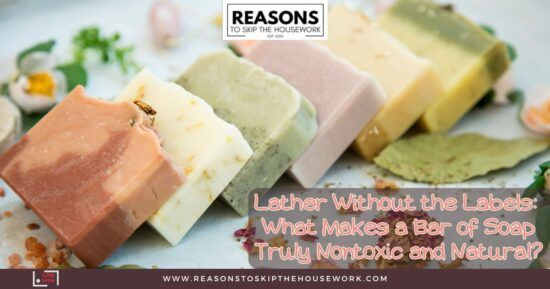If you’ve ever tried to shop for a nontoxic natural bar of soap, you’ve probably noticed how overwhelming the options can be. With so many products boasting “natural” or “pure” labels, it’s tough to know what really counts as safe and effective for your skin. This guide will help you decode the essentials—explaining what truly makes a soap bar nontoxic and natural, which ingredients to look for, which to avoid, and how to confidently choose a soap that supports both your skin and the environment.

Contents
Decoding ‘Natural’: Beyond Marketing Claims
Let’s face it—“natural” is one of the most overused and least regulated claims in the beauty industry, especially when it comes to soap. The FDA doesn’t strictly define what “natural” means, so many commercial brands use the term loosely. This leaves plenty of room for confusion and, unfortunately, for harsh or synthetic ingredients to sneak into products marketed as skin-friendly.
Traditional soap-making relies on the saponification of plant oils—a process that uses natural fats and an alkaline solution (like lye) to create soap. In contrast, many modern “soaps” are actually syndet (synthetic detergent) bars, which often contain artificial foaming agents, preservatives, and fragrances designed to mimic the feel of true soap without the same gentle benefits.
Why does this matter? Because ingredient transparency is key for both your skin and the planet. Understanding the difference between traditional and commercial soap helps ensure you’re choosing a product that not only cleanses effectively but also maintains your skin’s natural balance and minimizes environmental impact. In the next section, we’ll break down the building blocks of a truly natural soap bar and why they matter for everyday use.
The Foundation of Truly Natural Soap
When it comes to natural soap, the ingredients really do tell the whole story. A truly natural bar is built from saponified plant oils and enriched with gentle, beneficial additives. This isn’t just good marketing—it’s science-backed skincare that respects your skin’s natural defenses.
Beneficial Base Ingredients
The foundation of a high-quality natural soap starts with:
- Plant-based oils (olive, coconut, shea butter): These oils gently cleanse while helping your skin retain moisture, making them ideal for sensitive or dry skin types.
- Saponified oils: The traditional saponification process transforms these oils into soap without introducing harsh detergents, preserving the natural goodness of the original ingredients.
- Natural glycerin: This by-product of saponification is a powerful humectant, drawing moisture into the skin and preventing the tight, dry feeling often left by commercial soaps.
Clinical studies have shown that soaps made from saponified plant oils are less likely to strip away the protective lipid layer on your skin, reducing dryness and sensitivity (Source: International Journal of Cosmetic Science, 2017).
Beneficial Additives
Beyond the base, natural soaps often include:
- Botanical extracts (chamomile, calendula): These calm inflammation and can soothe irritation in sensitive skin.
- Natural clays: Help detoxify and gently exfoliate without disrupting your skin’s balance.
- Essential oils (in safe concentrations): Offer a subtle, natural fragrance and potential therapeutic benefits—think lavender for relaxation or tea tree for its antibacterial properties.
These additives not only enhance the cleansing experience but actively contribute to healthier, more resilient skin. Whenever you see a short, familiar ingredient list, you’re likely on the right track.
Red Flags: Ingredients to Avoid
Unfortunately, many soaps labeled as “natural” still contain ingredients that can be problematic for your skin and overall health. Here’s what to watch out for:
- Synthetic detergents (SLS/SLES): These create lots of lather but can strip away your skin’s natural oils, leaving it dry and irritated—especially for those with eczema or sensitive skin.
- Parabens: Used as preservatives, these have been linked to hormone disruption and can be absorbed through the skin with daily use.
- Artificial fragrances: These are often complex chemical mixtures that manufacturers aren’t required to disclose. They’re a leading cause of allergic reactions and sensitization, according to the American Contact Dermatitis Society.
- Triclosan: Once popular for its antibacterial properties, triclosan has been shown to disrupt hormone function and can contribute to antibiotic resistance.
- Artificial colorants: These petroleum-derived dyes serve no skin benefit and can increase irritation, particularly in sensitive or allergy-prone individuals.
Practical tip: If you see a long list of unpronounceable ingredients or vague terms like “fragrance” or “color,” it’s usually a sign to keep looking. Your skin—and your health—will thank you for steering clear.
Choosing a Truly Natural Soap Bar: Your Checklist
With so many options on the shelf, how can you tell if a soap bar is genuinely nontoxic and natural? Here’s a practical checklist to make your next purchase stress-free.
Label Claims vs. Reality
| Marketing Claim | What It Really Means | How to Verify |
|---|---|---|
| “Natural” | No legal definition; may still contain synthetics | Check for plant oils and recognizable ingredients |
| “Organic” | May refer to some ingredients only | Look for certified organic symbols (USDA, COSMOS) |
| “Fragrance-Free” | Free of synthetic scents, but may use essential oils | Read ingredient list for full transparency |
Your Natural Soap Checklist
- Short, recognizable ingredient list—with plant oils listed first
- Free from synthetic fragrances, SLS/SLES, parabens, and artificial colors
- Transparent manufacturing process and clear sourcing information
- Formulated for your specific skin type or concerns (e.g., sensitive, dry, acne-prone)
When shopping for a nontoxic natural bar of soap, prioritize products with transparent ingredient lists that highlight plant-based oils and botanical additives while clearly stating what they don’t contain. This approach helps you avoid common irritants and ensures you’re supporting your skin’s health every time you lather up.
Choosing a truly natural bar of soap isn’t just about falling for the prettiest packaging or the boldest claims. It’s about understanding what goes into your soap—and what stays out. Armed with these practical tips and checklists, you can confidently select a soap that supports your skin’s health and aligns with your values, one gentle wash at a time.
